Proa


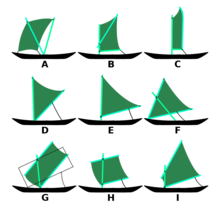
A:Double sprit (Sri Lanka)
B:Common sprit(Philippines)
C:Oceanic sprit(Tahiti)
D:Oceanic sprit (Marquesas)
E:Oceanic sprit (Philippines)
F:Crane sprit(Marshall Islands)
G:Rectangular boom lug(Maluku Islands)
H:Square boom lug(Gulf of Thailand)
I:Trapezial boom lug(Vietnam)
Proasare various types ofmulti-hulloutriggersailboatsof theAustronesian peoples.The terms were used for nativeAustronesian shipsin European records during theColonial eraindiscriminately, and thus can confusingly refer to the double-endedsingle-outriggerboats ofOceania,thedouble-outriggerboats ofIsland Southeast Asia,and sometimes ships with no outriggers or sails at all.
In its most common usage, the termproarefers to the Pacific proas which consist of two (usually) unequal-length parallelhulls.It is sailed so that one hull is kept towindward,and the other toleeward.It is double-ended, since it needs to "shunt"to reverse direction whentacking.It is most famously used for thesakmanships of theChamorro peopleof theNorthern Marianas,which were known as the "flying proas" for their remarkable speed.[2]
In Island Southeast Asia, the termproamay also sometimes be used, but the termsperahu,prau,prahu,parawandproware more common. These differ from the Pacific proas in that they are not double-ended and have atrimaranconfiguration with twooutriggers.These are widely used in the native ships ofIndonesia,Malaysia,and thePhilippines,and continue to be used today as traditional fishing, cargo, and transport vessels.
Proas are traditionally rigged with thecrab clawandtanja sails.The modern proa exists in a wide variety of forms, from the traditional archetype still common in areas described, to high-technology interpretations specifically designed for breaking speed-sailing records.
Etymology[edit]
The term "proa" originates fromEarly Modern English"prow" or "praw". It probably entered theEnglish languageviaDutchprauwandPortugueseparau,similar toSpanishproa,meaning "bow".It is likely ultimately derived fromMalayperahumeaning "boat", from theProto-Western-Malayo-Polynesiandoublets*parahu and *padaw, both meaning "sailboat". Itscognatesin otherAustronesian languagesincludeJavaneseprau,Sundaneseparahu,Kadazanpadau,Maranaopadaw,Cebuanoparáw,Ngadhabarau,Kiribatibaurua,Samoanfolau,Hawaiianhalau,andMāoriwharau.[3][4][5]
History[edit]
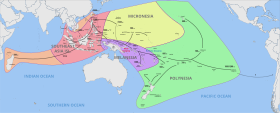
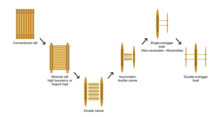
Catamaransandoutrigger boatswere very early innovations of theAustronesian peoplesand were the first true ocean-going ships capable of crossing vast distances of water. This enabled theAustronesian peoplesto rapidly spread fromTaiwanand colonize the islands of both thePacificandIndianoceans since at least 2200 BC. The first outriggers evolved from the more primitive double-hulledcatamarans.There are two types of outrigger ships based on the number ofoutriggers:the single-outriggers (which include catamarans with unequal hulls) and the double-outriggers (sometimes calledtrimarans). Single-outriggers evolved first and are the dominant form of Austronesians ships inOceaniaandMadagascar.They have largely been replaced by the more versatile double-outrigger ships inIsland Southeast Asia.Double-outrigger forms, however, are absent entirely in Oceania.[3][6][1]
Catamaran and outrigger technologies were introduced by Austronesian traders from Southeast Asia to theDravidian-speaking peoples ofSri LankaandSouthern Indiaas early as 1000 to 600 BC. This is still evident in the terms for "boat" inTamil,Telugu,andKannada(paṭavu,paḍava,andpaḍahu,respectively), which are all cognates ofProto-Western-Malayo-Polynesian*padaw. Early contact by Austronesians withArabsailors may have also influenced the development of thelateen sailin western ship traditions, derived from the more ancient Austronesiancrab claw sail.[3][7]
Many of these traditional vessels are now extinct. Either lost during the colonial period or supplanted in modern times by western boat designs or fitted with motor engines.[5][8]
Historical descriptions of the proa[edit]

ThePortuguesewere the first Europeans to encounter the double-outrigger Southeast Asian ships, initially with derivative vessels from theMalabar Coast,which they called theparau.They applied the same name to similar ships in their colonies in Southeast Asia. Similarly, the Dutch encountered them when they colonized the islands ofIndonesia,calling themprauw.This was rendered as "praw" by theBritish,later evolving to "proa". InFrenchterritories in the Pacific Islands, they were known by the more general termpirogue.Although technically restricted to outrigger sailing vessels, European sources often applied the term indiscriminately to any native ships of Southeast Asia.[2][5]
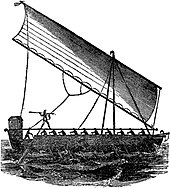

The earliest written accounts of the single-outrigger Pacific proa (though not by name) were by theVenetianscholarAntonio Pigafetta,who was part ofFerdinand Magellan's 1519–1522 circumnavigation. They encountered the nativesakmanships of theChamorro peoplein theIslas de los Ladrones(Mariana Islands). Pigafetta describes the outrigger layout of thesakman,and ability to switch bow for stern, and also notes its speed and maneuverability, noting, "And although the ships were under full sail, they passed between them and the small boats (fastened astern), very adroitly in those small boats of theirs." Pigafetta likened thesakmanto theVenetianfisolere,a narrow variety ofgondola.[9]

The accounts of Magellan's crew were the first to describe theChamorroproas as "flying." The subsequentcolonization of the Micronesia and the Philippinesprovided further references to proas inSpanishrecords.[8]They also described double-outrigger ships from thePhilippines,like the account of thekarakoainFrancisco Ignacio Alcina'sHistoria de las islas e indios de Bisayas(1668) which describes them as "sailing like birds."[10]
During his1740–1744 circumnavigation,Lord Ansonapplied the term proa to the double-ended Micronesian single-outrigger ships. His fleet captured one in 1742, andLt. Peircy BrettofHMSCenturionmade a detailed sketch of the proa.[11]Rev. Richard Walter, chaplain ofHMS Centurion,estimated the speed of the proa at twenty miles per hour (32 km/h).[2]Although aware of earlierSpanish accountsof the boats of theSpanish East Indies,Anson's account was the first detailed description of a Pacific proa to the English-speaking world.[12]In the subsequent voyages ofJames CookinPolynesia,he referred to the similar native single-outrigger canoes there as "proes", differentiating them from the double-hulledcatamaranswhich he called "pahee" (Tahitianpahi).[13]
These accounts fascinated both the British and American public, ushering in a period of interest in the design bysports sailors.Working from the drawings and descriptions of explorers, western builders often took liberties with the traditional designs, merging their interpretation of native designs with Western boat building methods. Thus this Western "proa" often diverged radically from the traditional "proa" to the point that the only shared feature was the windward/leeward hull arrangement.[12]
- The Proa darted like a shooting star
- Lord Byron,"The Island", 1823
Modern variations[edit]

In theMarshall Islands,where the craft were traditionally built, there has been a resurgence of interest in the proa. People hold annual kor-kor races in the lagoon atMajuro,along with events such as a children's riwut race. The kor-kors are built in traditional style out of traditional materials, though the sails are made with modern materials (often inexpensivepolyethylenetarpaulins,commonly known aspolytarp).
A loose group of individuals from all over the world has formed from those interested in the proa, including people with a historical perspective and those with a scientific and engineering perspective. Many such individuals are members of theAmateur Yacht Research Society.
Early Western proas[edit]
Sailing is no name for it – flying is better. Out into the bay she skipped, boys yelling with delight on the uplifted outrigger, spray from the lee bow and steering oar riven into vapor by the speed blowing to leeward.
— R. M. Munroe,"A Flying Proa",The Rudder,June 1898
In the late 19th century and early 20th century, many in Europe and America became interested in the proa. Western boat builders such asR. M. Munroeand Robert Barnwell Roosevelt (Theodore Roosevelt's uncle) reflected its influence. Into the 20th century, the proa was one of the fastest sailing craft that existed. The proa design is still the basis[14]for many boats involved inspeed sailing.
The first well-documented Western version of the proa was built in 1898 byCommodore Ralph Middleton Munroeof theBiscayne BayYacht Club. Yacht-design giantNathanael Herreshoff,a friend of Munroe, may have also had an interest in the project. A small model of the Anson-Brett proa is collected at the Herreshoff Marine Museum inRhode Island;its maker is uncertain.
Over the following years, Munroe built several more. They were all destroyed by the mid-1930s, when a severe hurricane leveled Munroe's bayside boatshop. At least two of his designs were documented in articles inThe Rudder,as was one by Robert B. Roosevelt. Small proas may have been brought back to the United States in the late 19th century, but documentation is sparse. Munroe and Roosevelt appeared to be the first two builders to adapt the proa to Western building techniques.
Royal Mersey Yacht Club[edit]
In 1860 a member of theRoyal Mersey Yacht ClubinEnglandbuilt a copy of a Micronesian proa. He used the traditional asymmetric hull, flat on the lee side, and a decked dugout ama. While no quantitative record was made of its speed, it was noted that the proa would run at speeds that would bury the bows of any other vessel. It carried three times the ratio of sail area to immersed midships section than the fastest yachts in the club and yet drew only 15 inches (38 cm).[2]
Munroe's 1898 proa[edit]
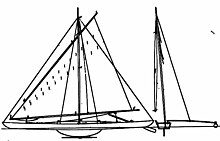
Since Munroe had no direct experience with proas, all he had to work with was the widely distributed and incorrect plan drawing from about 1742, made during Admiral Lord Anson's circumnavigation of the globe. This drawing had been circulated in the press, for example in William Alden's articles inHarper's Magazine.(These were reprinted in a small book calledThe Canoe and the Flying Proa.)[15]This proa was one of several either captured or seen under sail when Anson stopped atTinianduring a Pacific crossing. Brett, the draughtsman of the plan, is thought by some to have misinterpreted one key element, showing the mast fixed vertically in the center of the boat. This view as based on the fact that other Micronesian proa masts were raked end-to-end as the vessel shunted and the fact that a raked mast shifts the center of effort of the sail which would influence helm balance. However, Brett's placing of the mast in a vertical position has found to be accurate when replicas of the "Anson" proa were built and sailed by the Marinas-based organization 500 Sails that found that in many points of sail under many conditions the proa sailed well with the mast in a vertical position.[16]500 Sails also found that the mast could be raked to advantage in many situations and noted that the mast step depicted in the "Anson" drawing could be interpreted as depicting a rotational point rather than a rigid mast step that would not allow raking. 500 Sails canoes employ rotational mast steps that allow mast raking.
Munroe, however, was a talented boat designer who was able to work around any problems with the drawings. His adaptations can be seen in successive proas. Rather than the deep, asymmetric hull of a traditional proa, Munroe created flat-bottomed hulls (similar to thefisolerareferred to by Pigafetta),[9]with keels or centerboards for lateral resistance. His first iteration had an iron center fin with a half-oval profile. Rather than the traditional crab-claw sail's spars which meet at the front, Munroe's sails used what could be described as a triangularlug sailorspritsailwith a boom, similar to the modernlateensail with a shorter upper spar.
Munroe's first proa was only 30 feet (9.1 m) long, yet was capable of speeds which Munroe estimated at 18 knots (33 km/h). His article inThe Rudderdescribes what can only beplaningon the flat hull. As this was before the advent of planing power boats, this proa was one of the first boats capable of planing. This helped produce its amazing speed when most boats were limited to theirhull speed—they had too little power to achieve planing speed, and yet were not designed to exceedhull speedwithout planing. For example, a 30-foot (9.1 m) boat with too little power to plane, and with a hull form and displacement that didn't permit it to exceed hull speed without planing, would have a maximum speed of about 7.3 knots (13.5 km/h); Munroe's proa could reach nearly 2.5 times that speed. This accomplishment was the nautical equivalent to theX-1breaking the sound barrier.
It is not clear that traditional proas of the Pacific islanders could plane, though the long, slender hull would have a much higherspeed/length ratiothan other contemporary designs. Munroe was building a "cheap and dirty"sharpiehull made of two 32-foot (9.8 m) planks, a couple of bulkheads and a crossplanked bottom. By lucky accident he may have been the first sailor to plane his boat.[17]
Roosevelt's Mary & Lamb[edit]
Robert Barnwell Roosevelt,uncle ofAmerican PresidentTheodore Roosevelt,also built a proa at about the same time. He used it sailing fromLong Island.It was significantly different but equally creative, and at 50 feet (15 m), much longer. From his 1898 article inThe Rudder,it appeared the main hull of Roosevelt's proa was an open 4-foot (1.2 m) widescowhull; the ama was a smaller, fully decked scow which looked like it could rock on a single aka. The mast was a bipod arrangement with both masts stepped to windward, with a boomed, balanced lugsail suspended from the apex. A balanced rudder at each end managed itself by pivoting 180° when its end was the "bow", and leeboards were used.
Roosevelt's short article is accompanied by photographs showing his proaMary & Lamb,at rest and under sail. It is not clear if the boat predated Munroe's 1898 proa.
Munroe's 1900 Proa[edit]

Since Munroe wasn't aware of the raking mast, his 1900 model used twodaggerboardsset fore and aft of the mast, which would allow adjustment of the center of lateral resistance to provide helm balance. From the drawings, it appears the mast is higher as well, allowing a larger sail. The sail design also changed, with the upper spar now being slightly longer than the upper edge of the sail, and projecting past the apex slightly to allow the apex to be attached to the hull. The sail was loose footed, with the boom attached to the upper spar near the sail apex, and to the clew of the sail. His article in a 1900 issue ofThe Rudderincluded more details on the construction of his second proa. A 1948 book of sailboat plans published byThe Rudderincludes the following specifications for the 1900 proa:
- Length overall 30 feet (9.1 m)
- Beam (of main hull) 2 feet 6 inches (0.76 m)
- Draft of hull about 5 inches (13 cm)
- Draft with boards down 2 feet 5 inches (0.74 m)
- Sail area 240 square feet (22 m2)
From the drawings, the distance from the center of the main hull to the center of the aka is about 12 feet (3.7 m).
Other Western interpretations[edit]
Western designers often feel the need to tinker with the proa. They are attracted by the minimalist nature and amazing speeds that proas are capable of (they may still be the fastest sailboats per dollar spent for the home builder) but they often want the proa to do more; adding cabins, different sailing rigs, and bidirectional rudders are common changes made.James Wharramwas greatly influenced by the Proa design.
For example, unconventional boat and yacht designerPhil Bolgerdrew at least three proa designs; the smallest one (20 ft) has been built by several people while the larger two, including his Proa 60, have not been built. For additional examples, seehere.
Lee pods[edit]

The terms ama and aka have been adopted for the moderntrimaran.Since trimarans are generally designed to sail with one ama out of the water, they are similar to an Atlantic proa, with the buoyant leeward ama providing the bulk of the stability for the long, relatively thin main hull. Some modern proa designers have borrowed trimaran design elements for use in proas. Trimarans often have main hulls that are very narrow at the waterline, and flare out and extend over a significant portion of the akas. This topheavy design is only practical in a multihull, and it has been adapted by some proa designers. Notable examples are the designs of Russell Brown, a boat-fittings maker who designed and built his first proa,Jzero,in the mid-1970s. He has created a number of proa designs, all of which follow the same theme.
One of the design elements which Brown used, and a number of other designers have copied, is thelee pod.The akas extend past the main hull and out to the lee side, and provide support for a cabin extending to the lee of the main hull. This is similar to the platform extending to the lee on some Micronesian proas. The lee pod serves two purposes—it can be used for bunk space or storage, and it provides additional buoyancy on the lee side to prevent a capsize should the boat heel too far. Crew can also be moved onto the lee pod to provide additional heeling force in light winds, allowing the ama to lift under circumstances when it would not otherwise. TheJzeroalso used water ballast in the ama to allow the righting moment to be significantly increased if needed. While Brown's proa was designed to be a cruising yacht, not a speed-sailing boat, the newer 36-foot (11 m)Jzerrois capable of speeds of up to 21 knots (39 km/h).
Sail rigs[edit]
One of the issues Western designers have with the proa is the need to manipulate the sail when shunting. Even Munroe's early sails discarded the curved yards of the traditional crabclaw for the more familiar straight yards of the lateen and lug sails. Munroe's designs likely lacked the tilting mast because he was unaware of it, but many designers since have used a fixed mast, and provided some other way of adjusting the center of effort. Most sailboats are designed with the center of effort of the sails slightly ahead of the center of area of the underwater plane; this difference is called "lead." In a proa hull, and in all fore and aft symmetric foils, the center of resistance is not at or even near the center of the boat, it is well forward of the geometric center of area. Thus the center of effort of the sails needs to also be well forward, or at least needs to have a sail which is well forward which can be sheeted in to start the boat moving, allowing the rudders to bite and keep the boat from heading up when the entire sail area is sheeted in. Jzero, for example, and all of Russell Brown's other designs, use aslooprig and hoist a jib on whichever end is the current "bow". Other designs use a schooner rig for the same effect.
One of the more practical rigs for small proas was invented byEuell Gibbonsaround 1950 for a small, single handed proa. This rig was a loose footed lateen sail hung from a centered mast. The sail was symmetric across the yard, and to shunt, what was previously the top end of the yard was lowered and became the bottom end, reversing the direction of the sail. Proa enthusiastGary Dierkingmodified this design further, using a curved yard and a boom perpendicular to the yard. This allows a greater control of the sail shape than the traditional Gibbons rig, while retaining the simple shunting method, and is often referred to as theGibbons/Dierking rig.
Foils[edit]
While a proa is fairly efficient at minimizing the amount of wave drag and maximizing stability, there is at least one way to go even further. The use of underwaterfoilsto provide lift or downforce has been a popular idea recently in cutting-edge yacht building, and the proa is not immune to this influence.
TheBruce foilis a foil that provides a lateral resistance with zero heeling moment by placing the foil to either or both of the leeward and the windward sides, angled so the direction of the force passes through the center of effort of the sail. Since proas already have an outrigger to the windward side, a simple angled foil mounted on the ama becomes a Bruce foil, making the already stable proa even more stable. Bruce foils are often combined with inclined rigs, which results in a total cancellation of heeling forces. Inclined rigs are also well suited to the proa, as the direction of incline remains constant during shunting.
Another use of foils is to provide lift, turning the boat into ahydrofoil.Hydrofoils require significant speeds to work, but once the hull is lifted out of the water, the drag is significantly reduced. Many speed sailing designs have been based on a proa type configuration equipped with lifting foils.
Variations on the theme[edit]

In a non-traditional variant, first seen among Western yacht racers, the "Atlantic proa" has an ama which is always to the lee side to provide buoyancy for stability, rather than ballast as in a traditional proa. Because the Atlantic ama is at least as long as the main hull, to reduce wave drag, this style can also be thought of as an asymmetric catamaran that shunts rather than tacking. The first Atlantic proa was theCheers,designed in 1968 by boat designerDick Newickfor the 1968OSTARsolo transatlantic race, in which it placed third. Newkirk's designs are primarily trimarans, and the Atlantic proa's buoyant outrigger follows naturally from a conversion of a trimaran from a tacking to a shunting vessel.
Other proa designers blur the lines between Atlantic and Pacific style proas. TheHarryproafromAustraliauses a long, thin hull to lee, and a short, fat hull, containing the cabin, to windward. This would normally be more like an Atlantic proa, but the rig is on the lee hull, leaving it technically a Pacific design. This and other similar proas place the bulk of the passenger accommodations on the ama, in an attempt to make the vaka as streamlined as possible, and put much of the mass in the lee side to provide a greater righting moment.
Perhaps the most extreme variants of the proa are the ones designed for pure speed. These often completely discard symmetry, and are designed to sail only in one direction relative to the wind; performance in the other direction is either seriously compromised or impossible. These are "one way" proas, such as world record speed holdingYellow Pages Endeavour,orYPE.While the YPE is often called a trimaran, it would be more correct to call it a Pacific proa, because two of the planing/hydrofoil hulls are in line. This design has been considered by others as well, such as theMonomarandesigns by "The 40 knot Sailboat" author Bernard Smith, and these designs been called3-point proasby some, a reference to the 3 point hulls used inhydroplanes.[18]A previous record holding design, theCrossbow II,owned byTimothy Colmanwas a proa/catamaran hybrid. Crossbow II was a "slewing" catamaran, able to slew her hulls to allow clear airflow to her leeward bipod sail. Although the hulls appeared identical, the boat had all crew and controls, cockpit etc. in her windward hull; the leeward hull was stripped bare for minimal weight.
Speed records[edit]
In March 2009, two new sailing speed records were set by vehicles based on the proa concept, one on land, and one on the water.
On March 26, 2009,Simon McKeonand Tim Daddo set a new C-class speed sailing record of 50.08 knots (92.75 km/h) over 500 meters in the Macquarie Innovation, successor to their previous record holdingYellow Pages Endeavour,with a peak speed of 54 knots (100 km/h). The record was set in winds of 22 to 24 knots (44 km/h), and came close to taking the absolute speed record on water, currently held byl'Hydroptère.Conditions during the record-setting run were less than ideal for the Maquarie Innovation, which is anticipated to have a top speed of 58 knots (107 km/h) – 58 knots (67 mph).[19]
On March 27, 2009, Richard Jenkins set a world wind-powered speed record, on land, of 126.1 miles per hour (202.9 km/h) in the EcotricityGreenbird.This broke the previous record by 10 miles per hour (16 km/h). The Greenbird is based on a one-way proa design, with a long, thin two-wheeled body with a third wheel to the lee acting as an ama. The aka, which is in the shape of a wing, provides a significant amount of downwards force at speed to counter the heeling force generated by the high-aspect wing sail.[20][21]
See also[edit]
References[edit]
- ^abDoran, Edwin B. (1981).Wangka: Austronesian Canoe Origins.Texas A&M University Press.ISBN9780890961070.
- ^abcdFolkard, Henry Coleman (1853).The Sailing Boat: a description of English and foreign boats.London: Hunt and Son.
- ^abcdMahdi, Waruno (1999). "The Dispersal of Austronesian boat forms in the Indian Ocean". In Blench, Roger; Spriggs, Matthew (eds.).Archaeology and Language III: Artefacts languages, and texts.One World Archaeology. Vol. 34. Routledge. pp. 144–179.ISBN978-0415100540.
- ^American Heritage Dictionary of the English Language(5th ed.). Houghton Mifflin Harcourt. 2015.ISBN9780544454453.
- ^abcBlackburn, Graham (2003).The Illustrated Encyclopaedia of Ships and Boats.I.B.Tauris. p. 262.ISBN9781860648397.
- ^Doran, Edwin Jr. (1974)."Outrigger Ages".The Journal of the Polynesian Society.83(2): 130–140. Archived fromthe originalon 2019-06-08.Retrieved2019-06-22.
- ^Hourani, George F. (1951).Arab Seafaring: In the Indian Ocean in Ancient and Early Medieval Times.Princeton University Press. pp. 100–104.
- ^abGoetzfridt, Nicholas J."Proa and Navigation".Guampedia.Retrieved22 June2019.
- ^abEmma Helen Blair; James Alexander Robertson; Edward Gaylord Bourne (1906).The Philippine Islands, 1493–1803: Explorations by Early Navigators.A. H. Clark Co. p.99.
- ^Francisco Ignacio Alcina (1668).Historia de las islas e indios de Bisayas.
- ^"History: Drake and Anson".Retrieved2007-10-26.
- ^abCharnock, John (1802).An History of Marine Architecture.London: R. Faulder. pp. 313–316.
- ^Finney, Ben."Founding the Polynesian Voyaging Society; Building Hōkūle'a".Hawaiian Voyaging Traditions.Polynesian Voyaging Society.Retrieved22 June2019.
- ^"Mr Smith's Amazing Sailboats".Archived fromthe originalon 28 October 2009.
- ^"The Canoe, and The Flying Proa: or, Cheap Cruising and Safe Sailing, by W. L. Alden – The Online Books Page".onlinebooks.library.upenn.edu.
- ^500 Sails Executive Director and Chamorro Proa Builder Pete Perez
- ^"Gizmo".Retrieved2007-10-26."It planed although he didn't use that word because it hadn't been invented yet. I'm wondering if it was the first planing boat?" Jim Michalak
- ^Jobson, Gary (April 1998). "Breaking the 50-Knot Barrier".Yachting:28.
- ^"New World Speed Record: Macquarie Innovation breaks 50 – hits 54 knots".Sail-World.com. 28 March 2009.
- ^Tony Borroz (March 27, 2009)."Freaky Speeder Rides the Wind to World Record".Wired.
- ^"Greenbird official website".
- Haddon, A. C. & Hornell, James (1997).Canoes of Oceania.Honolulu, Hawaii: Bishop Museum Press.ISBN0-910240-19-1.
- Munroe, Ralph Middleton;Gilpin, Vincent (1930).The Commodore's Story.(New York): Ives Washburn. pp. 279–282.
- Manfred Meier & Othmar Karschulin (2024).The proa - The outrigger boat from past to present.Germany: Amazon.ISBN978-3-00-076976-4.
External links[edit]
Sources of information on proas[edit]
- Russel Brown on Proas,and interview with the builder of Kauri, Cimba, Jzero, and Jzerro, sloop rigged Pacific proas of 30 to 37 feet in length.
- Guampedia, Guam's Online Encyclopedia Agadna, Chamorro Canoe Builders
- The Proa Fileby Michael Schacht.
- German proa websiteInformation and links (mainly in German)
- A summary of American proa designs can be found on Craig O'Donnell'sCheap Pages.
- wikiproaa wiki dedicated to proas. Mostly home build smaller designs.
- A collection oflinks to Proa-related websitesfrom PacificProa.com
- The University of Guam's Traditional Seafaring Society WebpageMicronesiaArchived2007-09-14 at theWayback Machine.
- Canoes in Micronesiaby Marvin Montvel-Cohen; Micronesian working papers number 2, University of Guam Gallery of Art, David Robinson, Director, April 1970
- Big collection of photos of ancient proas
- 2001 Marshall Island stamps,showing the Marshallese walap
- Canoe Craze In Marshall Islands,Pacific Magazine, ByGiff Johnson.Shows modern kor-kor racers in traditional boats withpolytarpsails
- Riwuitpictures, anddetailed planson building and tuning a riwuit
- The Vaka Taumako Projectpage on Polynesian proas and sailing
- Essaywith photos of Kapingmarangi sailing canoes, Caroline Islands.
- Duckworks Magazinearticle on the R.B. Roosevelt and Monroe proas
- Waan Aelõñ in Majel (Canoes of the Marshall Islands)is a grassroots non-profit, non-government organization working with young Marshallese people.
Individual proa designs[edit]
- Proagenesis.org: Hinged vector fin proa
- World of Boats (EISCA) Collection ~ Ra Marama II, Fijian Proa
- Mbuli– A Pacific Proa
- P5– a 5 m multichine proa by Othmar Karschulin
- P8 - Kalapuna– an 8 m proa with crabclaw sail by Othmar Karschulin
- Harryproa website,detailing history and current developments of the Harry type proas
- Dave Culp'sArchived2006-05-01 at theWayback Machineuntested unidirectional, single foil proa
- Slingshot and Crossbow IArchived2006-05-01 at theWayback Machineshunting ama trimaran/proas
- Gary Dierking's T2proa design, showing the Gibbons/Dierking rig
- Cheers,the first Atlantic proa
- Rebuilding Cheers,by Vincent Besin
- Videoof Cheers' relaunch in 2006
- Videoof Jeremie Fischer's proaEquilibreshunting
- Video of ToroaMicronesian style proa, designed and built by Michael Toy and Harmen Hielkema
- Gizmo,an "experimental" minimalist proa by designerJim Michalak
- Mareinoa,a 12m cruising proa designed by Othmar Karschulin and built 2013 in Germany and sailed in the Baltic Sea]
- Madness– a 31-foot (9.4 m) Proa designed by John Harris





